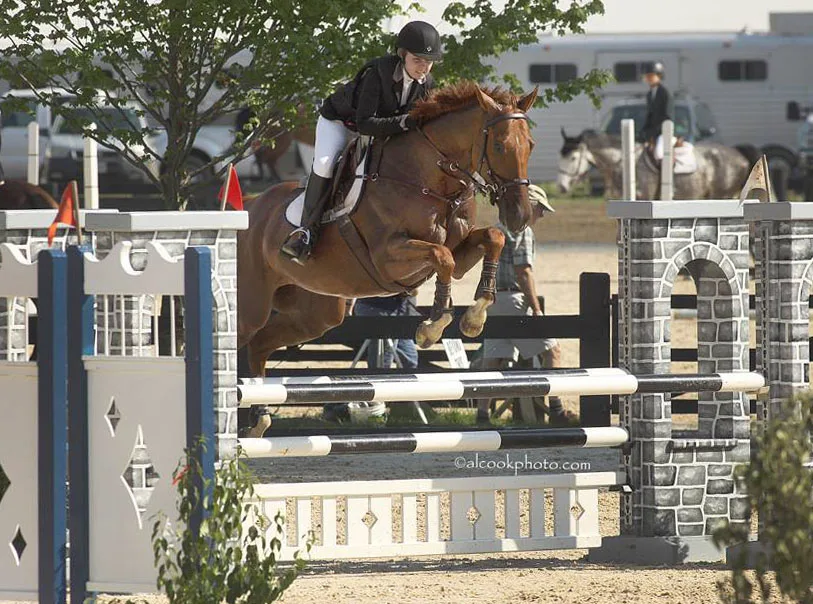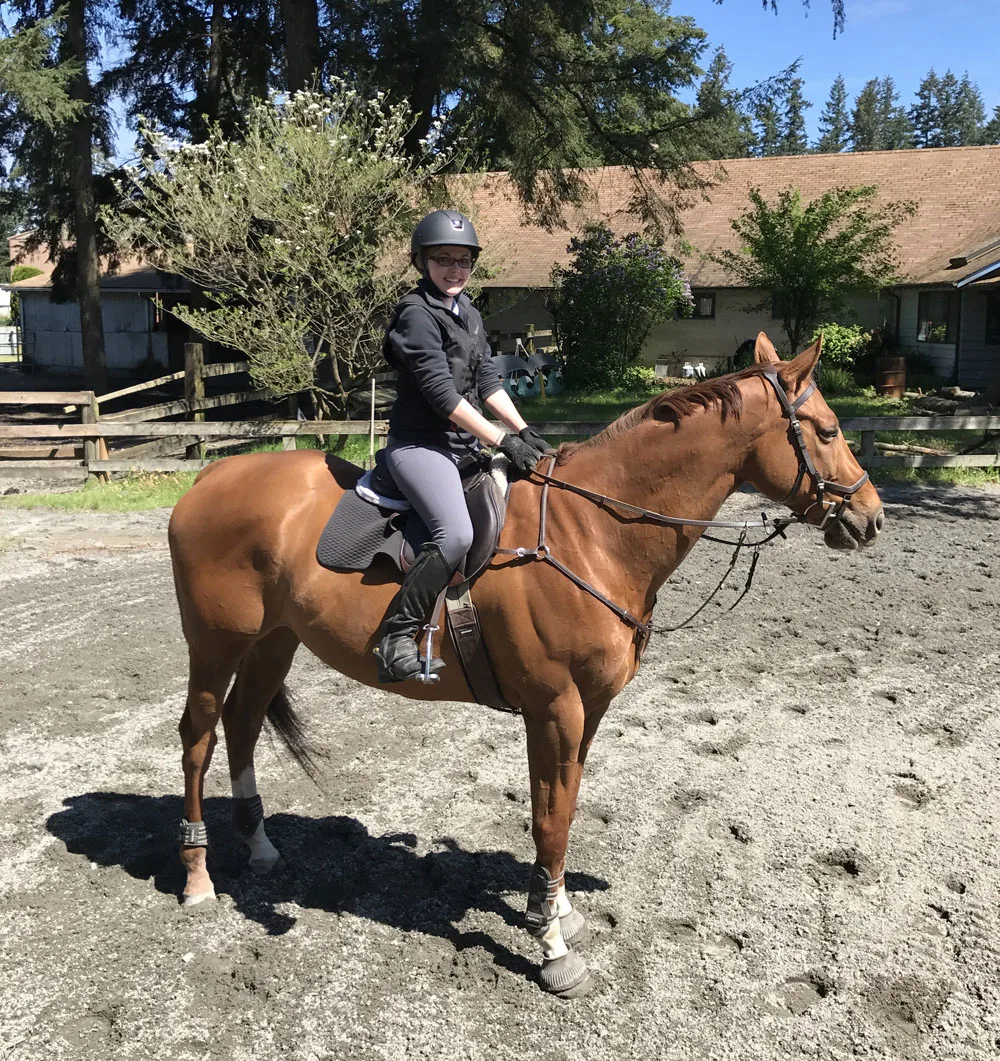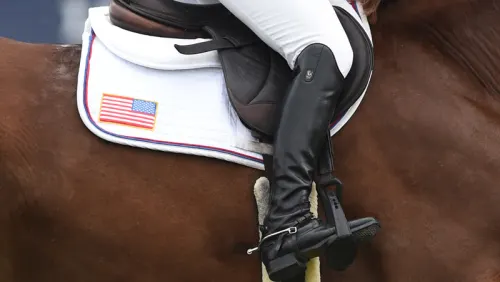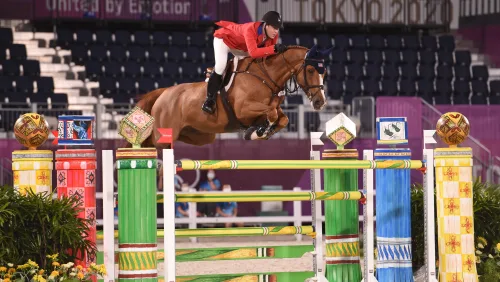When your surgeon says you may never ride again, that’s pretty much the last thing you hear him say. Everything else is just babble.
For Emily Coyle, like so many equestrians, riding is part of who she is. So when neurological symptoms from a cyst on her spinal cord showed up while she was working on her doctoral dissertation, the last thing she planned to do was stop competing her horse in the jumpers.
Two surgeries on her spine later, 29-year-old Coyle, a psychology professor at St. Martin’s University in Olympia, Washington, has not let anything slow her down.
She got her start in riding when she was 7 or 8 on Hershey, a pony she leased for pony camp and later bought. “He bucked me off when I tried him,” she remembered, “and my mom said, ‘Perfect, we’ll take that one.’”
Coyle and Hershey did eventing, pony jumpers, parades and swimming.
When she was ready to move up to a horse, her next mount was Harrison, her junior jumper until he retired. Along the way, Coyle, who is not easily daunted, decided she wanted to start a horse. She convinced her parents she needed a foal, and not just any foal—an unhandled Premarin draft horse foal.
Coyle got the filly after she spotted her on a 30-second clip of babies on a Premarin farm, and started her under saddle a couple of years later. “She actually was really a neat jumper,” Coyle said, and Hailey, show name, “Cheap Thrills,” was going to be the replacement for Harrison, who was retiring, despite the fact that Hailey “bucked like a rodeo bronc.”
Coyle was working on her dissertation proposal and showing Hailey in the adult jumpers when she suddenly began having neurological symptoms only on the left side of her body—a blurry eye, a dragging left foot and hand shaking. She had an emergency MRI, met with a neurosurgeon and was told she had a cyst on her spinal cord the size of a golf ball which would be life threatening or paralyzing if it ruptured.
“What should have scared me the most was the surgery,” which was both life-saving and life-threatening, Coyle said, but the surgeon told her the damage could be cumulative from riding and perhaps she couldn’t ride anymore. She was devastated.
“I don’t remember much about my first hospitalization,” Coyle said of the November 2013 surgery, but afterward, she remembered the surgeon telling her that riding was a possibility.
Sadly, as Coyle was going into her first surgery, Hailey got an infection in her poll, which turned to sepsis and, despite a number of surgeries, the mare had to be put down. “The cost of all the surgeries was the budget for the new horse,” Coyle said.
ADVERTISEMENT
So she replaced the bucking bronco Premarin mare with a wild off-the-track Thoroughbred, who for all his quirks, doesn’t buck. Best Coast, or “Westley,” is currently Coyle’s ride.
And bucking or no, the caveat Coyle was given was that if she was going to ride, she needed to wear an air vest, specifically the Hit Air Advantage, her doctor said. Coyle had to first recover from eight weeks of horizontal bed rest thanks to a spinal fluid leak, but she was soon back in the saddle.
With the vest on, Coyle said she was worried she’d look “like a total amateur, which I am.” But she’d done some pretty big jumpers in the past, competing in the high adults and the modified junior/amateur jumpers. With her green OTTB she was just doing “speed bumps,” so she did a little retail therapy and bought a black coat to match the vest.
Coyle soon discovered people don’t ask about the vest that much. Even better, Olympian Joe Fargis also wears an air vest, which inspired her.
“Falling for me is just a bigger deal,” Coyle said, thanks to the surgeries that have left her with an unprotected spot on her back.
Leap forward three years and Coyle had completed her doctorate at Pennsylvania State University, with a dissertation on Influences on Children’s Play with a STEM Toy: Interactions Among Children, Parents, and Gender-Based Marketing, taught for year at Beloit College (Wisconsin) and moved back across the country to the Pacific Northwest, where she had grown up, to take a tenure-track position as an assistant professor in the Department of Psychology at Saint Martin’s University (Washington).
A glance at Coyle’s curriculum vitae shows she is as dedicated to her career as she is to her riding. She completed her doctorate before she was 30 and has at least nine scholarly articles published and two under revision. Broadly, Coyle’s research relates to “how social group membership shapes personal cognition, intergroup cognition, and ultimately outcomes like achievement, aspiration, and interest.”
In 2017, in her first year as a tenure-track faculty member, the symptoms came back, but worse.
Thanks to her shaking hand, “I broke every water glass in the house,” but conveniently, Coyle laughed, the prizes at the Cascade horse show series in Washington were etched glasses, “so I won them back.”
The neurosurgeon said the cysts on her spine were not from riding after all, but because her spinal cord was tethered. Spinal cords should hang free, Coyle explained, but hers is attached, and her doctor theorized that was causing the cysts. It’s a birth defect, she said, similar to spina bifida. Tethered cord syndrome in adults means attachments cause an abnormal stretching of the spinal cord, according to the National Institutes of Health. The earlier surgery is done, the better chance the patient has the symptoms can be fixed.
Coyle had surgery in April 2017. Her horse headed down to California to compete without her.
ADVERTISEMENT
It’s a long-term solution, Coyle said, but a bleaker diagnosis since “those nerves have been pulled on for almost 30 years.”
Only 48 hours after surgery she was allowed to take a couple of steps in a harness, and she’s been fighting her way back into the saddle ever since.
In terms of her riding, Coyle has lost sensation on the inside of her left leg. “I can use the muscles, but I can’t feel them, which is kind of a weird thing. I can look down and know my leg is working but can’t feel it on the inside,” she said.
Keeping her heel down stresses the nerve that runs from the bottom of her spinal cord along the outside of her leg to her foot, so her foot goes numb.
Coyle said since April there‘s been a lot of physical therapy and managing what symptoms will be permanent and what will not, including the damage to that nerve.
After waiting six weeks after surgery for her incision to heal, Coyle was back in the saddle, starting with a few minutes on a walking hack and increasing from there.
Trainers Jennifer Hansen and Tami Masters of Starfire Farm in Lakewood, Washington, have had to change their coaching style a little for Coyle, who doesn’t always know where her foot is and needs to be told.
In June, 10 weeks after surgery she was back in the show ring doing the .75-meter jumpers on Westley, and by July the duo had moved up to the .90s. At first she had to dismount using a mounting block.
Coyle can do most things by herself, but fiancé Trevor Christensen makes sure she doesn’t do lift anything heavy like a tack trunk, strictly forbidden as she’s not allowed to lift heavy items, and makes sure she doesn’t ride any crazy horses.
The Hit Air vest is a confidence booster for Coyle. Her only fly in the ointment is that Westley, post recovery from a bout with EPM, finds it harder to be careful over the even bigger fences that Coyle would like to return to. So she’s casually looking for another mount that will take her to a higher level. She’s not one to sell horses, and likes to keep tabs on her former mounts. She still keeps up with Harrison, who totes people around on the Penn State equestrian team where she donated him and Hershey, who teaches lessons on the East Coast. And she also plots buying a pony for Christensen’s 3-year-old son.
As she looks to the future, and to bigger fences, Coyle’s medical saga and her return to riding and competing mean that it’s been “an interesting journey, that now feels exciting,” now that she knows she can continue following her dreams in the saddle.



















